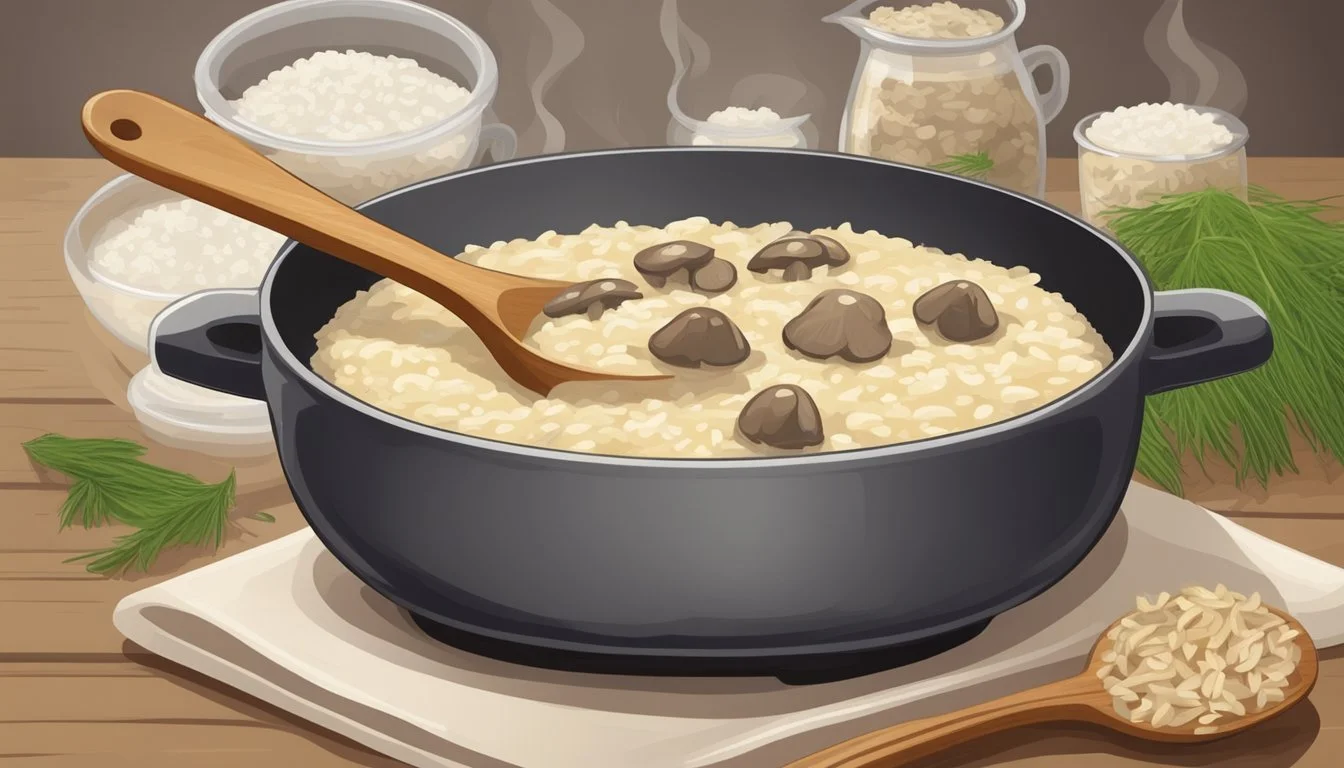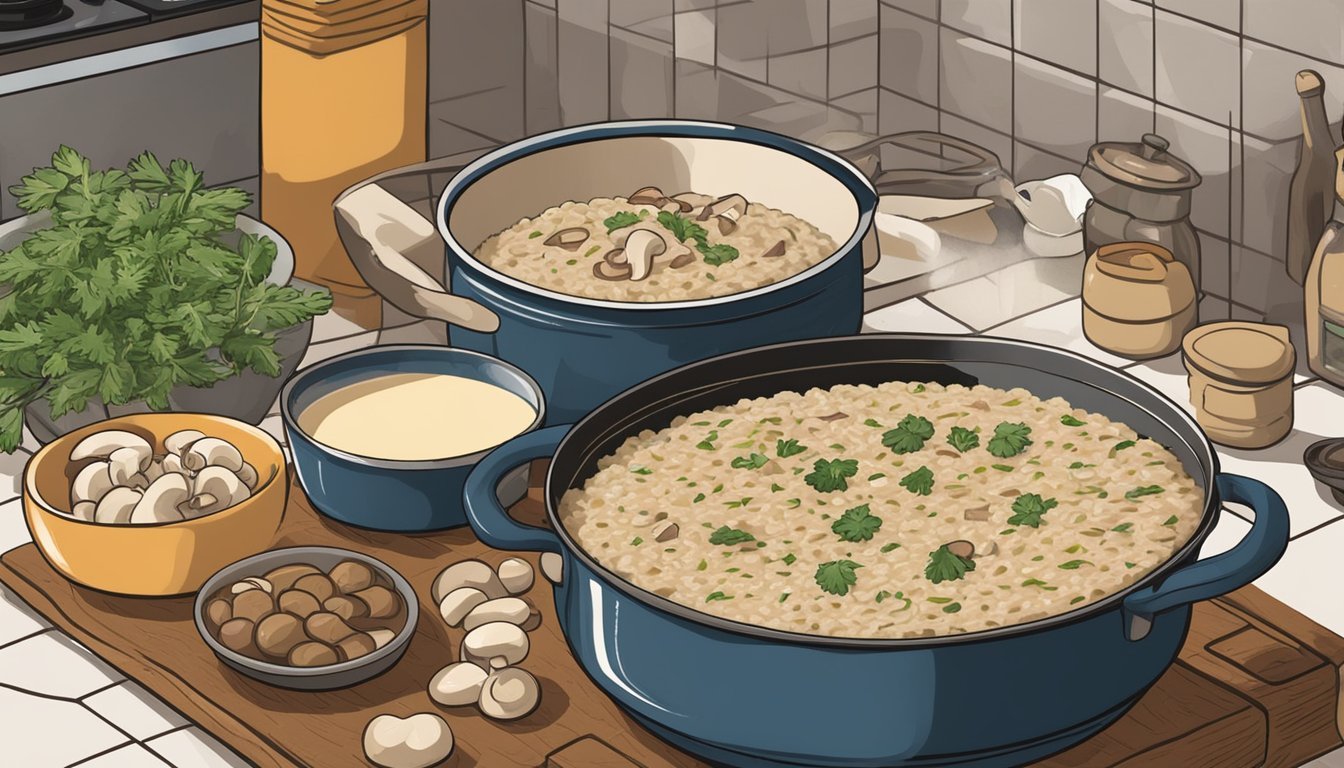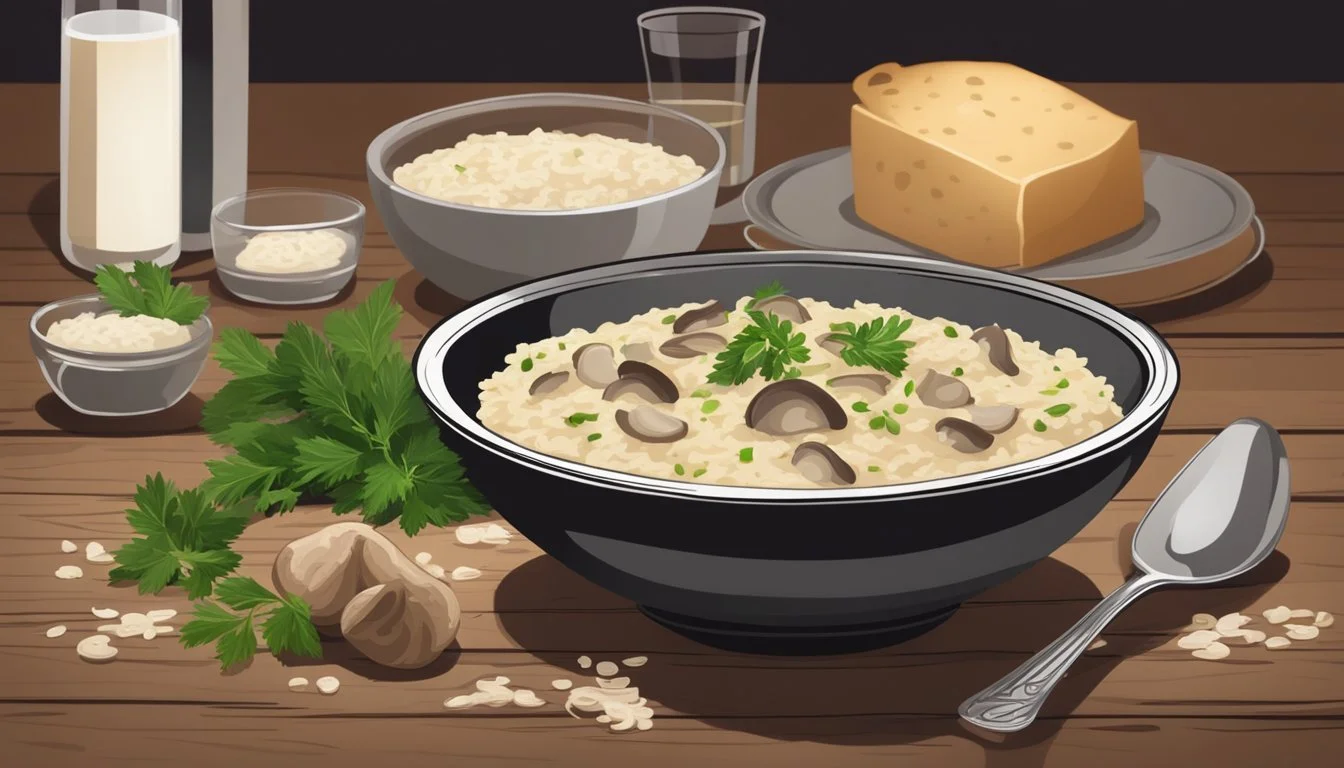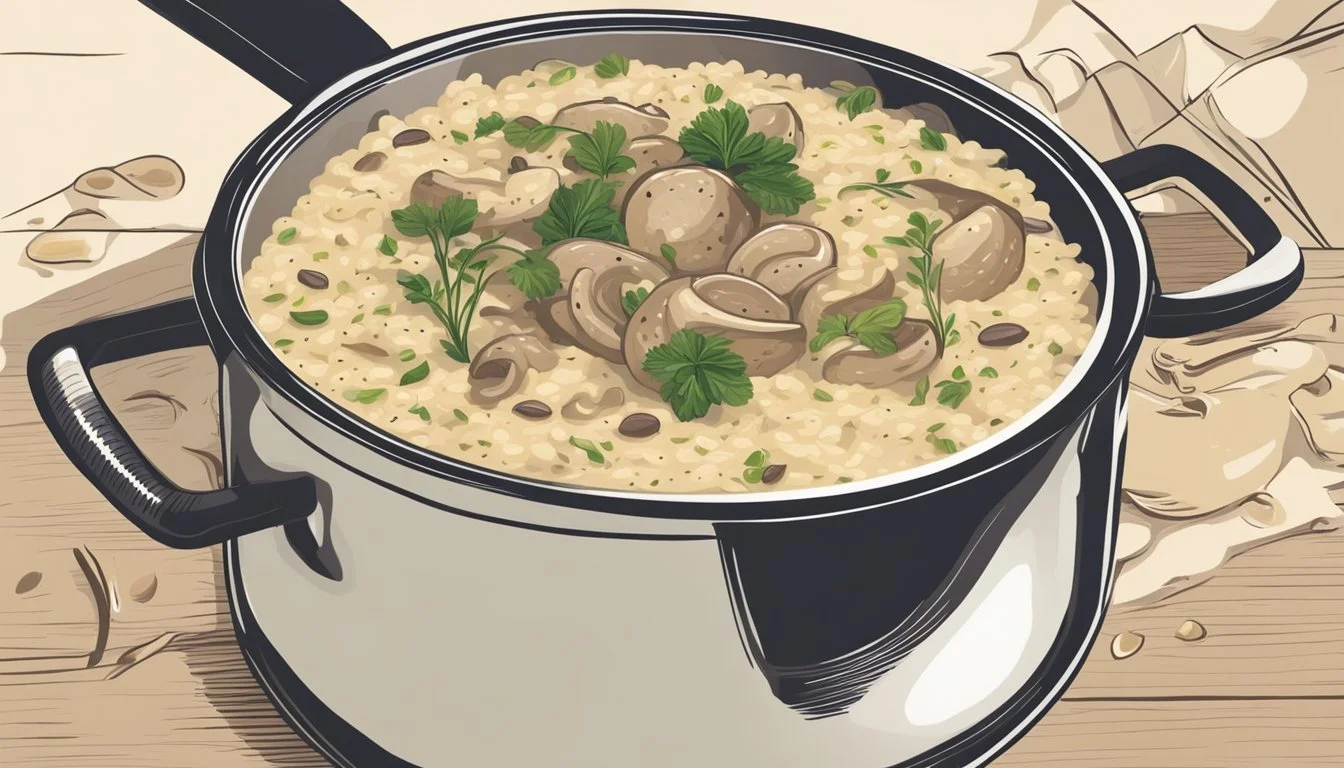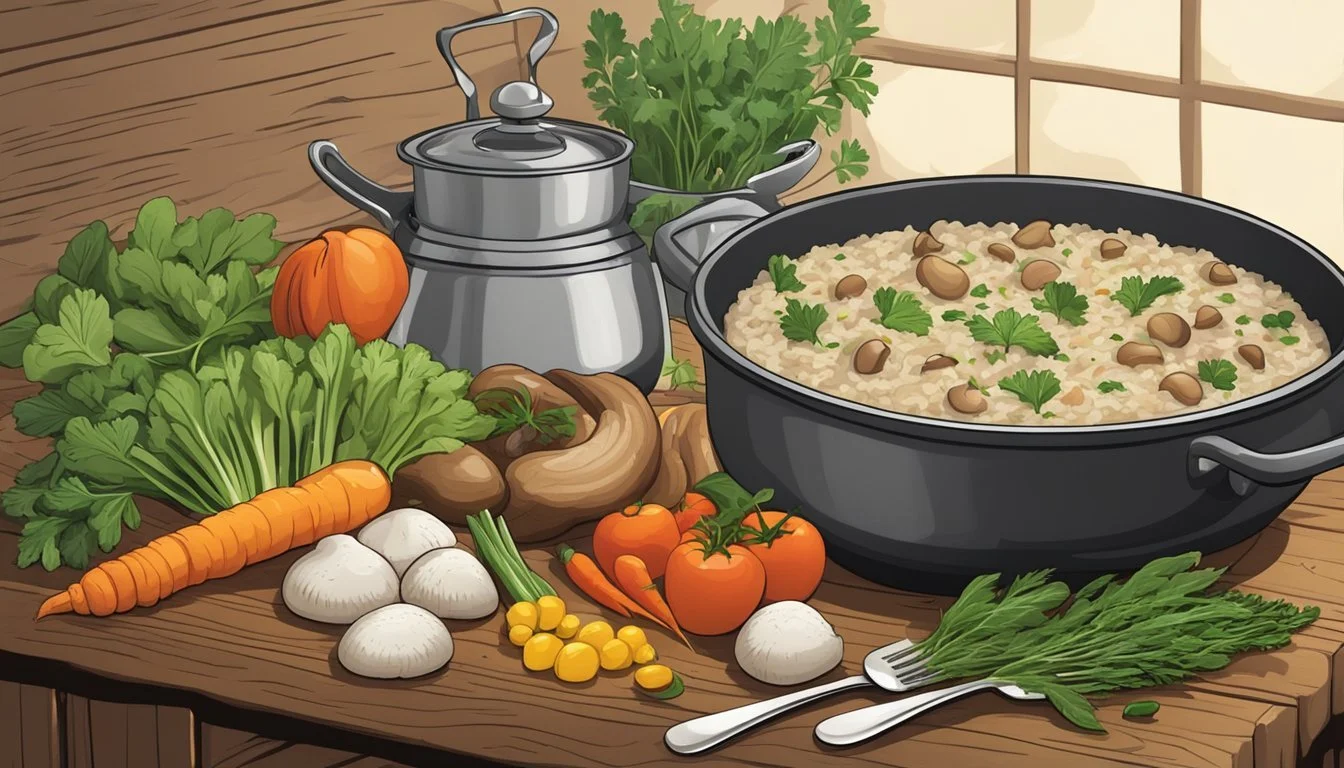Mushroom Stem Risotto
A Hearty, Flavorful Main Course Perfect for Any Dinner Table
Mushroom stem risotto elevates the traditional rice dish to a heartier main course, perfect for those who seek a satisfying and flavorful meal. Utilizing the often-overlooked stems of mushrooms (What wine goes well with mushrooms?), this variation not only brings a unique texture but also contributes to a no-waste cooking approach. The stems of mushrooms such as king oyster or other varieties provide a meaty bite that is both sustainable and delicious. When incorporated into a creamy risotto, these stems absorb the rich flavors of the broth and aromatics, transforming the dish into a well-rounded main course.
The key to a successful mushroom risotto (What wine goes well with mushroom risotto?) lies in the technique. A slow and attentive cooking process allows the arborio rice to release its starch gradually, creating a naturally creamy consistency without the need for excessive dairy. The addition of the mushroom stems happens early in the cooking process to ensure they are well-integrated and tender by the time the dish is completed. Seasoned with herbs and quality olive oil, each bite of this risotto promises a symphony of earthy flavors (What wine goes well with earthy flavors?) that are both comforting and impressive to any palate.
As a main course, mushroom stem risotto stands proudly on its own or can be paired with a simple side of greens for balance. It's a versatile dish that can be adapted to various tastes and dietary requirements, making it a reliable choice for both casual family dinners and more formal gatherings. This thoughtful use of ingredients showcases the potential of underutilized produce, further establishing mushroom stem risotto as a testament to culinary ingenuity and responsible cooking.
Choosing the Right Rice
Selecting the appropriate variety of rice is essential for a successful risotto. Opting for rice with high starch content is crucial, as it gives risotto its signature creamy texture.
Types of Risotto Rice
Risotto rice can be classified into several types, each with unique properties making them suitable for this traditional Italian dish. The main characteristic they share is a high starch content, necessary to achieve the creamy consistency risotto is known for. The most popular types include Arborio, Carnaroli, Vialone Nano, and Baldo.
Arborio: Common and accessible; known for its high starch content and ability to absorb liquids.
Carnaroli: Often favored by chefs for its firmer texture and better absorption, leading to creamier risotto.
Vialone Nano: Smaller grains but exceptional at absorbing flavors, suitable for quicker cooking risotto.
Baldo: Similar to Arborio but with a firmer texture, absorbing flavors well.
Arborio Rice Characteristics
Arborio rice is perhaps the most widely used rice for making risotto due to its availability and high starch content. The grains are medium to large, with a characteristic white dot at the center. Arborio rice can absorb considerable amounts of liquid without becoming mushy, making it an excellent carrier for the flavors of mushroom stem and other risotto ingredients.
Grain size: Medium to large
Starch content: High, producing a creamy texture when cooked
Carnaroli and Other Varieties
Carnaroli rice is considered by many as the premier risotto rice, sometimes referred to as the 'king' of risotto rice. It boasts a higher starch content than Arborio and maintains its al dente texture throughout the cooking process.
Carnaroli: High starch content, firmer texture, excellent liquid absorption.
Other Varieties:
Vialone Nano: Ideal for creamy and velvety risotto, requires less cooking time.
Baldo: Resilient to overcooking, versatile for different risotto recipes.
It's essential to choose a rice that complements the recipe's ingredients and suits the desired consistency of the risotto.
Mushroom Varieties
Selecting the right type of mushroom is essential for crafting a rich and savory mushroom risotto. This section explores common mushrooms suited for risotto as well as distinctive flavors that can elevate the dish.
Common Mushroom Types for Risotto
Cremini Mushrooms: Also known as baby bellas, cremini mushrooms are young portobellos. They impart a mild and earthy flavor that enhances the risotto's depth.
Button Mushrooms: These are the most accessible mushrooms and contribute a subtle taste.
Oyster Mushrooms: Recognizable for their fan-shaped caps, oyster mushrooms offer a delicate and slightly woody flavor.
Shiitake Mushrooms: They are prized for their rich, buttery taste and are often used to add a more complex flavor profile to risotto.
Unique Mushroom Flavors
Porcini Mushrooms: Admired for their robust and nutty taste, porcinis are often used in their dried form to intensify the umami flavor in risotto.
Chanterelles: These mushrooms are sought after for their peppery and slightly fruity notes that can add a unique twist to the dish.
When selecting mushrooms for risotto, chefs should consider the intensity of the mushroom's flavor and how it will complement the other ingredients in their recipe. A blend of different mushrooms can also be used to create a more nuanced and hearty main course.
Preparation Basics
Crafting a savory Mushroom Stem Risotto requires attention to detail and quality ingredients. This section breaks down the essentials of the dish, ensuring a flavorful and creamy outcome.
Ingredient Overview
The foundation of Mushroom Stem Risotto lies in its ingredients, each bringing a unique element to the dish:
Oils & Fats: Olive oil and butter for sautéing and richness.
Aromatics: Onion and garlic provide a fragrant base when sweated in oil.
Herbs & Seasonings: Thyme, fresh parsley, salt, and pepper for depth and balance.
Cheese: Parmesan cheese for umami and a creamy texture post-cooking.
Liquids: White wine for acidity and flavor; broth to cook the rice to perfection.
Rice: Arborio rice is preferred for its starch content, which aids in creating the signature creamy consistency.
The Importance of Prep Time
Prep time is vital and should not be underestimated, as it lays the groundwork for seamless cooking. Begin by finely chopping the onion and mincing the garlic to ensure even cooking and distribution of flavor. Measure out the thyme and parsley, and have the salt and pepper at hand for easy seasoning. Grate the Parmesan cheese and set aside, keeping it at room temperature to meld into the risotto effortlessly when added later. Ensure the broth is heated prior to starting the risotto to maintain cooking momentum and support the starch release from the rice, thus achieving a creamy texture without curdling.
Cooking Techniques
In crafting a Mushroom Stem Risotto, each step is essential for developing flavors and achieving the desired creamy texture. Mastery of certain cooking techniques is crucial in creating a risotto that stands out as a hearty and flavorful main course.
Sautéing Onion and Garlic
The foundation of Mushroom Stem Risotto begins with sautéing onions and garlic. He warms olive oil over medium heat, adding finely chopped onions and minced garlic until they're translucent and aromatic. This base is essential for imparting a deep, savory flavor to the dish.
The Role of Stirring in Risotto
Stirring is integral to risotto, as it ensures the rice cooks evenly and releases starch for a creamy consistency. She stirs continuously, allowing the rice grains to rub against one another, creating the signature creaminess without the need for heavy creams or excessive saturated fats.
Layering Flavors
Layering flavors is achieved by initially toasting the rice and then deglazing the pan with white wine. Deglazing with wine adds an acidic component that complements the umami flavor of the mushrooms. They follow by ladling in warm broth gradually, which further intensifies the risotto's depth of flavor.
Achieving the Perfect Texture
For the desired texture, she maintains a consistent simmer and adds broth slowly, allowing the rice to absorb the liquid. He watches for the rice to become al dente—soft with a slight bite. At this point, they incorporate the mushroom stems, which contribute to the hearty texture of the risotto.
Final Touches and Seasoning
They finish the risotto with butter, enhancing richness, and stir in freshly grated nutty Parmesan cheese. Seasoning with parsley, thyme, and black pepper introduces complexity and brightness. Each addition is thoughtfully considered to ensure a balanced, creamy, and satisfying final dish.
Nutritional Information
Mushroom stem risotto offers a substantial and savory dining experience, with a nutritional profile that reflects a balance of macronutrients while being mindful of sodium and cholesterol levels.
Caloric and Macronutrient Content
Mushroom stem risotto is a dish that provides an array of macronutrients. A standard serving size typically contains the following:
Calories: Approximately 250-300 kcal
Protein: 8-10 grams
Total Fat: 4-6 grams
Saturated Fat: 1-2 grams
Monounsaturated Fat: Quantities vary, key for heart health
Polyunsaturated Fat: Usually present in small amounts
Trans Fat: Negligible amounts, if any
Carbohydrates: 45-50 grams
Fiber: 2-4 grams, supporting digestive health
Cholesterol: Minimal cholesterol levels, beneficial for heart health
Understanding Sodium and Cholesterol
Conscious preparation of mushroom stem risotto can help maintain control over sodium and cholesterol content.
Sodium: Keeping added salt to a minimum, one serving can contain:
Sodium: Approximately 300-400 mg; attention to broth and seasoning can lower this.
Cholesterol: This dish typically includes negligible cholesterol, unless additional high-cholesterol ingredients are added.
Including mushroom stems not only utilizes the often-discarded parts of the mushroom, but they also contribute essential nutrients:
Potassium: Helps counteract the effects of sodium and is important for heart function.
Vitamins:
Vitamin A: Found in mushrooms, albeit in smaller amounts.
Vitamin C: Not naturally high in mushrooms but may be present depending on added ingredients like parsley or vegetables.
Minerals:
Calcium and Iron: While not as high as in other food sources, they are present and contribute to the overall dietary value of the dish.
Serving Suggestions
To maximize the enjoyment of Mushroom Stem Risotto as a main course, one should consider the presentation and complementary side dishes that can enhance its earthy and rich flavor profile.
Proper Plating
For an appealing presentation, the risotto should be served on a flat plate with a slight rim. A spacious plate allows the risotto to be spread out, showcasing its creamy texture and the even distribution of mushrooms and herbs. The risotto is best spooned into the center of the plate, creating a mound for an attractive height. A garnish of fresh parsley or thyme adds a pop of color and a hint of freshness to the dish.
Pairing with Side Dishes
Side Dishes to Consider:
Salad: A simple green salad dressed with vinaigrette complements the risotto’s richness and provides a refreshing balance.
Protein: For non-vegetarians, chicken piccata (What wine goes well with chicken piccata?) or baked chicken breast makes a wholesome addition, offering a source of lean protein that pairs well with the flavors of the risotto.
Bread: Italic_Garlic bread, with its crisp texture and aromatic flavor, acts as an excellent accompaniment for guests to soak up any remaining sauce.
The key is to select side dishes that contrast with the risotto's creamy consistency while harmonizing with its savory taste.
Storing and Reheating
Proper storage and reheating techniques ensure that leftover Mushroom Stem Risotto maintains its taste and texture. This section outlines how to preserve leftovers and the best practices for reheating them.
Preserving Leftovers
When storing leftover risotto, one should promptly place it in an airtight container to prevent it from drying out. The risotto should be cooled to room temperature before being sealed and placed in the refrigerator. For optimal freshness, leftover risotto should be consumed within two days. If one needs to store it longer, freezing is an option. Risotto can be frozen for up to one month. To freeze, portion the risotto into single-serving sizes in airtight containers or heavy-duty freezer bags.
Best Practices for Reheating
When reheating risotto, gently restoring its creaminess is key. Bring the refrigerated risotto to room temperature for even reheating. For stovetop reheating, add a small amount of broth or water to the risotto to loosen it, stirring constantly over low heat until it’s heated through. Alternatively, one can reheat risotto in the microwave—cover the risotto with a damp paper towel and use a low-power setting in 30-second intervals, stirring in between, until it's hot. Avoid overheating as it can dry out the risotto and affect its texture.
Recipe Variations and Serving Ideas
Mushroom stem risotto serves as a comforting and elegant vegetarian meal that can be easily customized with various ingredients to suit different tastes and dietary needs.
Creative Twists on Classic Risotto
To add a creative twist to a classic mushroom risotto recipe, chefs may consider incorporating alternative grains such as farro or barley for a different texture. Adding a splash of white wine enhances the flavor, and stirring in a variety of fresh herbs such as thyme or parsley can elevate the dish with fresh aromatics. For textural contrast, one can top the risotto with toasted nuts or seeds.
To make the dish even more hearty, they might include additional vegetables like spinach or asparagus. For non-vegetarians, a topping of crisped pancetta or roasted chicken can add an extra layer of flavor.
Catering to Dietary Preferences
For those catering to specific dietary preferences, there exist multiple ways to modify the mushroom risotto recipe. For a vegan option, cooks can substitute butter with olive oil and use nutritional yeast or a vegan Parmesan alternative to mimic the cheesy flavor.
An instant pot can also be utilized to make an easy-to-prepare version of mushroom risotto, where all the ingredients can be combined and cooked under pressure, reducing the need for constant stirring.
Gluten-free adaptations are straightforward as risotto rice, such as Arborio or Carnaroli, is naturally gluten-free. It's important to ensure that all broth and wine used are also gluten-free.
Bold flavors can be achieved by incorporating a mix of wild mushrooms or a drizzle of truffle oil before serving to leave diners with a lasting impression of the meal's depth and richness.
Summary and Cooking Time
In preparing Mushroom Stem Risotto, the home cook will engage in a process that integrates sautéing, toasting of risotto rice, and a gradual addition of broth. This section will provide a review of the essential steps and the time allocation necessary for this main course.
Review of Key Points
Mushroom Preparation: The stems of mushrooms are sautéed until they release their moisture and turn golden brown.
Toasting Rice: Risotto rice is then toasted to a point where its edges become slightly translucent.
Broth Addition: Broth is incorporated incrementally, allowing each addition to be absorbed before introducing more, until the risotto reaches a creamy consistency.
Total Time Estimate
The overall cooking time for Mushroom Stem Risotto can vary, but here's a detailed estimate:
Preparation Time: 10 minutes for cleaning and chopping ingredients
Cook Time: Approximately 18-30 minutes for toasting rice and adding broth
Stage Time Estimate Prep Work 10 minutes Sautéing Stems 5-10 minutes Toasting Rice 3-4 minutes Cooking Risotto 18-30 minutes Total Time 36-54 minutes
Note: The total time does not take into account any resting or additional feature time such as if the recipe requires letting the risotto set.
Additional Tips
In crafting the perfect Mushroom Stem Risotto, there are nuances that make a significant difference in the result. Seasoned with expert insights and highlighting the ideal tools, these additional tips will elevate the dish from satisfactory to sensational.
Expert Advice for First-Timers
For those embarking on this culinary journey, one should prioritize the use of a large skillet to allow for even cooking of the risotto. Warm broth is also pivotal; it should be added gradually, ensuring each ladleful is absorbed before introducing more. This meticulous process is what gives risotto its creamy consistency. Including fresh thyme can profoundly enhance the flavors, adding an earthy aroma that complements the mushrooms. When it comes to the aromatics like onions or shallots, these should be finely chopped and sautéed until translucent to provide a sweet and savory foundation for the risotto.
Recommendations for Tools and Equipment
Utilizing the right equipment is instrumental in achieving the desired texture and flavor. Below is a list of essential tools:
Large skillet: A must-have for ample space to sauté and simmer the risotto evenly.
Ladle: For incrementally adding the broth.
Wooden spoon: Ideal for stirring the risotto, as it prevents sticking and doesn't react with acids.
Cutting board and sharp knife: Essential for prepping the shallots and other ingredients.
Equipment Use Large Skillet Even sautéing and simmering Ladle Adding broth gradually Wooden Spoon Stirring without sticking Cutting Board Prepping ingredients Sharp Knife Finely chopping shallots, onions, and mushrooms
For optimal results, one should ensure that all the tools are at hand before beginning to cook, as the process requires constant attention.
Engaging with Your Audience
Engaging with your audience is crucial for sharing your culinary journey and gaining valuable insights. It transforms the dining experience from a solitary event to a communal exchange.
Sharing on Social Media
Culinary enthusiasts can capture the essence of Mushroom Stem Risotto by sharing images and cooking tips on social platforms. Pinterest is ideal for reaching food lovers, as it allows users to pin and organize recipes into visually appealing boards. When posting:
Use High-Quality Photos: A well-presented dish can entice users to try and share your recipe.
Include Step-by-Step Guides: Detailed pins can help followers replicate your risotto successfully.
Encouraging Feedback
Feedback opens the door to improvement and innovation. It’s important to foster a two-way conversation by:
Responding to Comments: Acknowledge each comment to make your followers feel heard and valued.
Asking Questions: Encourage followers to share their own experiences with the recipe or offer suggestions for variations.
Incorporating these strategies can enhance your culinary presence and establish you as a knowledgeable source for heartwarming and delicious meals.
Conclusion
Mushroom stem risotto, with its hearty grains and rich flavors, stands as a versatile dish suited for various occasions. It embodies a delightful interplay of textures and tastes, emanating from well-sauteed mushrooms and perfectly cooked Arborio rice. The key to a successful risotto lies in patience and precision, ensuring that each grain of rice is tender and has absorbed the fragrant stock.
Essential elements for enhancing the dish include:
Butter: For a silky finish
Parmesan Cheese: Adds depth
Truffle Oil (optional): For a gourmet flair
Fresh Herbs: Such as parsley, infuse freshness
As they prepare this dish, aspiring chefs should remember to maintain a balance of flavors. One should neither overpower the delicate earthiness of the mushrooms nor under-season the risotto. Moreover, consistency is crucial; the risotto should be creamy but not overly thick.
This dish can be served as a substantial main course or as a sophisticated side dish, adaptable to one's dietary preferences. Variations may include the addition of other vegetables or proteins, though the classic mushroom risotto maintains its popularity for its uncomplicated yet comforting taste profile.
In conclusion, mushroom stem risotto presents a culinary experience that is both nourishing and indulgent. It reflects the art of cooking—a process that combines simple, quality ingredients to create a meal that is satisfying to both the palate and the soul.


